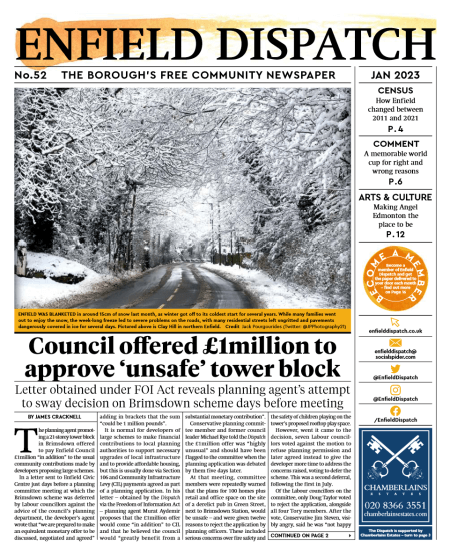In issue 52 of Enfield Dispatch
- The Dispatch reveals that Enfield Council was offered £1million to approve an ‘unsafe’ tower block in Brimsdown days before a planning committee meeting;
- the promotion of a lease of Whitewebbs Park to Tottenham Hotspur sparks anger;
- new Census 2021 data reveals how Enfield has changed;
- a veteran sports journalist gives his verdict on Qatar 2022;
- an Enfield primary school opens its own foodbank for parents;
- find out why Fore Street is becoming the place to be;
- how a new local art project is looking beyond the individual;
- and meet the man who always knows Enfield Town FC’s opponents inside out.
Snow: Very pretty, but hazardous...
Also featured on the Dispatch's front page is a photograph of Clay Hill during the period when snow was on ground. As the caption says, "While many families went out to enjoy the snow, the week-long freeze led to severe problems on the roads, with many residential streets left ungritted and pavements dangerously covered in ice for several days."
Enfield was probably far from alone in not dealing adequately with the snow, and cuts in government funding to local government undoubtedly played a part. And how realistic is gritting residential side roads? But the snow was forecast and surely some gritting on main roads on the afternoon and evening when it snowed could have kept the buses running that night and the following morning?
But by far the worst impact was felt by pedestrians. A slight thaw followed by days of subzero temperatures rendered pavements a deadly hazard for anyone for whom a fall could result in serious injury, especially when the ambulance service and accident and emergency services are on the brink of collapse following a decade of neglect. Many people without access to cars were effectively stranded at home for the best part of a week. How is this compatible with the new hierarchy set out in the last issue of the Highway Code, with pedestrians at the top, followed by horseriders and cyclists, and only then by car drivers?
Links
Download January's Enfield Dispatch
Council offered £1million to approve ‘unsafe’ tower block (Enfield Dispatch 30 December 2022)
Labour councillors refuse to reject ‘unsafe’ tower (Enfield Dispatch 19 October 2022)
Become a member of Enfield Dispatch and support local independent media





